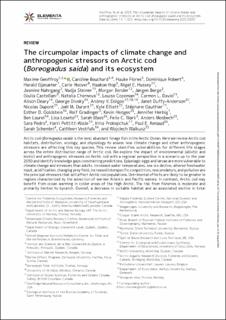| dc.contributor.author | Geoffroy, Maxime | |
| dc.contributor.author | Bouchard, Caroline | |
| dc.contributor.author | Flores, Hauke | |
| dc.contributor.author | Robert, Dominique | |
| dc.contributor.author | Gjøsæter, Harald | |
| dc.contributor.author | Hoover, Carie | |
| dc.contributor.author | Hop, Haakon | |
| dc.contributor.author | Hussey, Nigel E. | |
| dc.contributor.author | Nahrgang, Jasmine | |
| dc.contributor.author | Steiner, Nadja | |
| dc.contributor.author | Bender, Morgan | |
| dc.contributor.author | Berge, Jørgen | |
| dc.contributor.author | Castellani, Giulina | |
| dc.contributor.author | Chernova, Natalia | |
| dc.contributor.author | Copeman, Louise | |
| dc.contributor.author | David, Carmen | |
| dc.contributor.author | Deary, Alison | |
| dc.contributor.author | Divoky, George | |
| dc.contributor.author | Dolgov, Andrey | |
| dc.contributor.author | Duffy-Anderson, Janet | |
| dc.contributor.author | Dupont, Nicolas | |
| dc.contributor.author | Durant, Joël M. | |
| dc.contributor.author | Elliott, Kyle | |
| dc.contributor.author | Gauthier, Stéphane | |
| dc.contributor.author | Goldstein, Esther D. | |
| dc.contributor.author | Rolf, Gradinger | |
| dc.contributor.author | Hedges, Kevin | |
| dc.contributor.author | Herbig, Jennifer | |
| dc.contributor.author | Laurel, Ben | |
| dc.contributor.author | Loseto, Lisa | |
| dc.contributor.author | Maes, Sarah | |
| dc.contributor.author | Mark, Felix | |
| dc.contributor.author | Mosbech, Anders | |
| dc.contributor.author | Pedro, Sara | |
| dc.contributor.author | Petitt-Wade, Harri | |
| dc.contributor.author | Prokopchuk, Irina | |
| dc.contributor.author | Paul E, Renaud | |
| dc.contributor.author | Schembri, Sarah | |
| dc.contributor.author | Vestfals, Cathleen | |
| dc.contributor.author | Walkusz, Wojciech | |
| dc.date.accessioned | 2023-09-01T10:55:14Z | |
| dc.date.available | 2023-09-01T10:55:14Z | |
| dc.date.created | 2023-08-21T09:03:57Z | |
| dc.date.issued | 2023 | |
| dc.identifier.citation | Elementa: Science of the Anthropocene. 2023, 11 1-44. | |
| dc.identifier.issn | 2325-1026 | |
| dc.identifier.uri | https://hdl.handle.net/11250/3087002 | |
| dc.description.abstract | Arctic cod biomass are predicted. In most Arctic seas, the relative abundance of Arctic cod within the fish community will likely fluctuate in accordance with cold and warm periods. A reduced abundance of Arctic cod will negatively affect the abundance, distribution, and physiological condition of certain predators, whereas some predators will successfully adapt to a more boreal diet. Regional management measures that recognize thecritical roleof Arcticcod arerequiredtoensure that increased anthropogenic activities do not exacerbate the impacts of climate change on Arctic marine ecosystems. Ultimately, the mitigation of habitat loss for Arctic cod will only be achieved through a global reduction in carbon emissions. | |
| dc.description.abstract | The circumpolar impacts of climate change and anthropogenic stressors on Arctic cod (Boreogadus saida) and its ecosystem | |
| dc.language.iso | eng | |
| dc.title | The circumpolar impacts of climate change and anthropogenic stressors on Arctic cod (Boreogadus saida) and its ecosystem | |
| dc.title.alternative | The circumpolar impacts of climate change and anthropogenic stressors on Arctic cod (Boreogadus saida) and its ecosystem | |
| dc.type | Peer reviewed | |
| dc.type | Journal article | |
| dc.description.version | publishedVersion | |
| dc.source.pagenumber | 1-44 | |
| dc.source.volume | 11 | |
| dc.source.journal | Elementa: Science of the Anthropocene | |
| dc.identifier.doi | 10.1525/elementa.2022.00097 | |
| dc.identifier.cristin | 2168311 | |
| cristin.ispublished | true | |
| cristin.fulltext | original | |
| cristin.qualitycode | 1 | |
